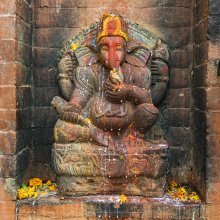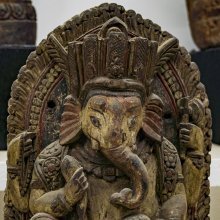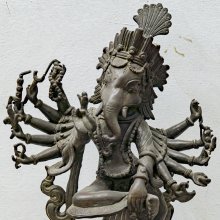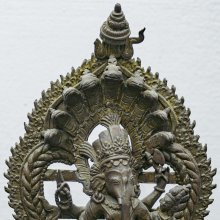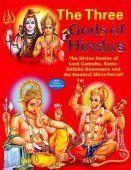Ganesha, Gaṇeśa, Gāṇeśa, Ganeśa, Gana-isha: 32 definitions
Introduction:
Ganesha means something in Buddhism, Pali, Hinduism, Sanskrit, Jainism, Prakrit, the history of ancient India, Marathi, Hindi. If you want to know the exact meaning, history, etymology or English translation of this term then check out the descriptions on this page. Add your comment or reference to a book if you want to contribute to this summary article.
The Sanskrit terms Gaṇeśa and Gāṇeśa and Ganeśa can be transliterated into English as Ganesa or Ganesha, using the IAST transliteration scheme (?).
Alternative spellings of this word include Ganesh.
Images (photo gallery)
(+69 more images available)
In Hinduism
Ganapatya (worship of Ganesha)
Source: Google Books: Ganesh: Studies of an Asian GodThe Suprabhedāgama is reported to contain a story according to which Śiva and Pārvatī, when they retired to a forest on the slopes of the Himālayas to enjoy themselves, saw two elephants making love. This excited their passion, and they decided to transform themselves into elephants. As a result, Gaṇeśa, too, was born with the face of an elephant. See T. S. Gopinath Rao, Elements of Hindu Iconography, 1.1:44-45.
According to Jayaratha’s Hara-carita-cintāmaṇi (chap. 18) Gaṇeśa was born, not with one but with five elephants’ heads, which were later reduced to one by Śiva. See Encyclopaedia of Religion and Ethics, ed. James Hastings, 2:807-8.
Source: om.ru: Ashtavinayak (8 temples of Ganesha)Ganesha is considered the God of wisdom and prudence, is an expert in scriptures and a good scribe. At the direction of the sage Vyasa, he wrote down the Mahabharata. Before agreeing to this, Ganesha set a condition that dictation should never fail, and sage Vyasa, in turn, said that Ganapati should not write down slokas without understanding the meaning.
It is said that Ganesha’s huge body and capacious belly symbolize the cosmos, or the universe, and the head of an elephant with a trunk, which is usually shown turned to the left, symbolizes “OM”. [...] Ganesha’s awkward and obese physical form reminds us that the beauty of the outer form has nothing to do with the inner beauty and spiritual perfection of Ganesha. The mouse indicates the equal importance of the largest and the smallest being in the eyes of the Supreme God.
Ganapatya (गाणपत्य, gāṇapatya) represents a tradition of Hinduism where Ganesha is revered and worshipped as the prime deity (ishta-devata). Being a minor though influential movement, Ganapatya evovled, llike Shaktism and Shaivism, as a separate movement leaving behind a large body of literature.
Shilpashastra (iconography)
Source: Red Zambala: Hindu Icons and Symbols | Inner Circle IVGaṇeśa—“The god of Wisdom and the patron of learning”—Everything that we perceive in the universe must be grasped and expressed by the mind through the means of categories, therefore “category” is a fundamental principle of existence. The ‘principle’ by which all classifications, and the relationship of one thing to another in the universe can be understood is called Gaṇa-eṣa (“The-Lord-of-Categories”).
Gaṇeśa represents one of the basic concepts of Hindu Philosophy—the identity between the macrocosm and the microcosm. In religious terms this is the identity between the individual and the universe (humankind made in the image of God).
In iconography Gaṇeśa is represented as an Elephant-headed man: The man part of Gaṇeśa represents the manifest Principle which is subordinate to the unmanifest Principle which is represented by the elephant's head. The elephant head also represents certain qualities to which a sincere spiritual seeker is encouraged to aspire — strength, intelligence, endurance and gracefulness.
Source: Archaeological Survey of India: Śaiva monuments at Paṭṭadakal (śilpa)Gaṇeśa (गणेश) is found as a sculpture at the temple of Lokeśvara, south wall, southern façade.—Gaṇeśa seated in lalitāsana. His head is shown in profile, facing west with his trunk up. His right foot is folded and placed on the throne, whereas his left leg is hanging. His lower two hands hold something which looks like a serpent. Probably he is tying it around his belly. His upper right hand is in dolahasta, hanging straight, whereas the upper left is bent in an angle and held in sarpaśīrṣa pose. He wears probably a small crown. With his hands and trunk he draws a figure that looks like a svastika, an auspicious sign. The emplacement of his hands and trunk, dishevelled hair, draws something like edges of two triśūla or tridents in horizontal position. He wears one necklace and an udarabandha, a belt on his stomach or sarpabandha. His paunch is not that big as in many later images.
Gaṇeśa (गणेश) is also found as a sculpture on the eastern wall of the outer maṇḍapa of the temple of Pāpanātha.—Gaṇeśa has the pose of padmāsana lotus, on a lotus seat, where the petals are clearly visible. There is a manuscript in his right hand and the left holds a modaka with his trunk applied on it to relish it. A small tiara adorns his head. He is lambodara, big tummy.

Shilpashastra (शिल्पशास्त्र, śilpaśāstra) represents the ancient Indian science (shastra) of creative arts (shilpa) such as sculpture, iconography and painting. Closely related to Vastushastra (architecture), they often share the same literature.
Vaishnavism (Vaishava dharma)
Source: ISKCON Press: GlossaryGaṇeśa (गणेश).—The demigod in charge of material opulence and freedom from misfortune. He is the son of Lord Śiva and Pārvatī, and is the scribe who wrote down the Mahābhārata.
Source: Pure Bhakti: Bhagavad-gita (4th edition)Gaṇeśa (गणेश) refers to “elephant scribe of Vyāsadeva”. (cf. Glossary page from Śrīmad-Bhagavad-Gītā).
Source: Pure Bhakti: Brhad BhagavatamrtamGaṇeśa (गणेश) refers to:—Son of Śrī Śiva; demigod with the head of an elephant who is worshiped for wealth and freedom from misfortune. He removes obstacles on the path of bhakti. (cf. Glossary page from Śrī Bṛhad-bhāgavatāmṛta).

Vaishnava (वैष्णव, vaiṣṇava) or vaishnavism (vaiṣṇavism) represents a tradition of Hinduism worshipping Vishnu as the supreme Lord. Similar to the Shaktism and Shaivism traditions, Vaishnavism also developed as an individual movement, famous for its exposition of the dashavatara (‘ten avatars of Vishnu’).
Purana and Itihasa (epic history)
Source: archive.org: Nilamata Purana: a cultural and literary studyGaṇeśa (गणेश) is one of the sons of Śiva: a deity once worshipped in ancient Kashmir (Kaśmīra) according to the Nīlamatapurāṇa.—The term Gaṇeśa occurs twice only in the Nīlamata, once for Śiva’s gaṇa (not bull) Nandī, and secondly for various images having different names but the common epithet Gaṇeśa. The manuscripts of the longer redaction refer to Gaṇeśa a third time also in connection with Dhanada Caturthī.
Source: archive.org: Shiva Purana - English TranslationGaṇeśa (गणेश) is the name of a deity, as defined in the Śivapurāṇa 1.16. Accordingly, “by the worship of Gaṇeśa the devotee shall attain his wish in this world itself. The days of special worship of Gaṇeśa are Fridays, the fourth day of the bright half of the lunar months of Śrāvaṇa and Bhādrapada, and the Śatabhiṣak star of the month of Dhanus. He shall be worshipped duly on these days. Or the devotee shall worship continuously for hundred or thousand days”.
Source: Cologne Digital Sanskrit Dictionaries: The Purana Index1a) Gaṇeśa (गणेश).—Is Vināyaka (s.v.); sprung out of Kāmeśvara, thought of by Lalītā; destroyed Bhaṇḍa's followers and filled the Śakti host with enthusiasm. Killed Gajāsura (s.v.). His riding animal was rat. Lalitā honoured him as the first to be worshipped among gods;1 was Nikumbha in whose honour Divodāsa built a temple.2 The head of a Śiva gaṇa who sports in sidda-kṣetras, Rathyas, desolate gardens and places where there are children, the mad and others. Icons of;3 origin in an elephant-faced doll made by Pārvatī from the oil and dirt scraped off her body in the course of an oil bath; cast into Ganges where he grew in size and became Gāngeya.4
- 1) Bhāgavata-purāṇa III. 41. 37-41: 42. 2 and 33: 43. 18 and 31: 44. 70. Brahmāṇḍa-purāṇa IV. 27. 72-104: 44. 67.
- 2) Brahmāṇḍa-purāṇa III. 67. 55.
- 3) Matsya-purāṇa 23. 38 and 84: 154. 524, 533-41: 250. 25, 259. 23.
- 4) Matsya-purāṇa 154. 502-5.
1b) Formerly men who by brahmacarya and pilgrimages pleased Śankara and attained this status; very dear to Śiva; Pārvatī's first view of them; their habits and food; Vīraka, (s.v.) one of them attracted Pārvatī's attention.*
- * Matsya-purāṇa 154. 522. to 41.
Gaṇeśa (गणेश) or Gaṇapati is the name of a deity mentioned in the 10th century Saurapurāṇa: one of the various Upapurāṇas depicting Śaivism.—The Saurapurāṇa doesn’t give the genesis of Gaṇeśa nor does it refer any feat of the deity. [...] From the description of the Durvāgaṇapati-vrata many facts about the deity are known. He is Vināyaka, Gajānana, Śūra, Heramba, Ekadanta, Vighnarāja, Son of Umā, Lambodara, Vīra, Gaṇādhyakṣa etc. His birth from the bodily-dart of Pārvatī is hinted at ([...]) and he was born to kill the demons ([...]). The Ṛgvedic mantra [gaṇānāṃ tvā gaṇapatiṃ havanmahe] etc. is employed in his worship.

The Purana (पुराण, purāṇas) refers to Sanskrit literature preserving ancient India’s vast cultural history, including historical legends, religious ceremonies, various arts and sciences. The eighteen mahapuranas total over 400,000 shlokas (metrical couplets) and date to at least several centuries BCE.
Vedanta (school of philosophy)
Source: Shodhganga: Siva Gita A Critical StudyGaneśa (गनेश) or Ganeśagītā refers to one of the sixty-four Gītās commonly referred to in Hindu scriptures.—Gītā is the name given to certain sacred writings in verse (often in the form of a dialogue) which are devoted to the exposition of particular religious and theosophical doctrines. Most of these Gītās [i.e., Ganeśa-gītā] originate from the Mahābhārata or the various Purāṇas.

Vedanta (वेदान्त, vedānta) refers to a school of orthodox Hindu philosophy (astika), drawing its subject-matter from the Upanishads. There are a number of sub-schools of Vedanta, however all of them expound on the basic teaching of the ultimate reality (brahman) and liberation (moksha) of the individual soul (atman).
General definition (in Hinduism)
Source: Wisdom Library: HinduismGanesha is the son of Lord Shiva & Goddess Parvati and he is prayed during the Ganesh Chaturthi. The name Ganesha is a Sanskrit compound, joining the words gana which connotes group, multitude and isha meaning lord or master. Ganesha is shown with a pot -belly because it is the Hindu idea of beauty and signs of well-fed prosperity.It is believed that Ganesha`s head signifies Atman the Highest Reality while the body below the neck represents Maya ,the principle of phenomenal existence. Ganesha`s ears, which appear like large winnowing baskets, have a philosophical significance too.
Source: WikiPedia: HinduismGaṇesha (गणेश): The god of good fortune, commonly identified for his elephant head.
Source: Academia.edu: The Kapalik GanapatiThe Goddess Pārvatī gave birth to Gaṇeśa during a long-lasting absence of her husband Śiva. When Śiva returned he found a young boy–Gaṇeśa–near his residence. Assuming the boy was an enemy the outraged Śiva decapitated the boy. This, of course, caused immense grief to Pārvatī. So, in order to comfort his wife Śiva quickly revived Gaṇeśa’s life by seizing the first head of a living being he encountered. The first living creature he encountered happened to be an elephant, thus Śiva decapitated the elephant’s head and put it on Gaṇeśa’s body.
In Buddhism
Tibetan Buddhism (Vajrayana or tantric Buddhism)
Source: academia.edu: A Collection of Tantric Ritual TextsGaṇeśa (गणेश) is the name of an ancient Tibetan tantric deity.—The Newari people of Nepal worship both the Buddha and Gaṇeśa and sometimes even Śiva. In the Tibetan canon there are some hymns and sādhanas dedicated to Gaṇapati, one of the forms of Gaṇeśa, considered also by Buddhists as an emanation of Avalokiteśvara.
Source: OSU Press: Cakrasamvara SamadhiGaṇeśa (गणेश) is the name of a deity, according to the Guru Mandala Worship (maṇḍalārcana) ritual often performed in combination with the Cakrasaṃvara Samādhi, which refers to the primary pūjā and sādhanā practice of Newah Mahāyāna-Vajrayāna Buddhists in Nepal.

Tibetan Buddhism includes schools such as Nyingma, Kadampa, Kagyu and Gelug. Their primary canon of literature is divided in two broad categories: The Kangyur, which consists of Buddha’s words, and the Tengyur, which includes commentaries from various sources. Esotericism and tantra techniques (vajrayāna) are collected indepently.
In Jainism
General definition (in Jainism)
Source: archive.org: The Jaina IconographyGaṇeśa (गणेश) or Gaṇapati is the name of a deity commonly depicted in Jaina art and iconography.—Gaṇeśa’s hands vary from two, four, six, nine, eighteen to one-hundred and eight. According to the description of the Ācāradinakara, Gaṇapati should be pot-bellied and should hold, in his hands, an axe, Varada, Modaka (Sweet-meat ball), and Abhaya. His vehicle is a mouse. The form of Gaṇapati with four hands seems to be standard. The symbols of axe, Modaka and mouse are exactly the same with those of the Brahmanic Gaṇeśa. Hence, we may reasonably conclude that the icon of this god is the result of one of the many assimilations which Jainism made from Brahmanism.

Jainism is an Indian religion of Dharma whose doctrine revolves around harmlessness (ahimsa) towards every living being. The two major branches (Digambara and Svetambara) of Jainism stimulate self-control (or, shramana, ‘self-reliance’) and spiritual development through a path of peace for the soul to progess to the ultimate goal.
India history and geography
Source: Singhi Jain Series: Ratnaprabha-suri’s Kuvalayamala-katha (history)Gaṇeśa (गणेश) (=Gaṇādhipa) refers to one of the deities being worshiped in ancient India, as vividly depicted in the Kathās (narrative poems) such as Uddyotanasūri in his 8th-century Kuvalayamālā (a Prakrit Campū, similar to Kāvya poetry).—The Kuvalayamala (779 A.D.) is full of cultural material which gains in value because of the firm date of its composition. [...] Page 256.31-2 ff.: Here is a mixed list of 25 gods and Godlings of all religions. These were worshipped and propitiated to obtain favours. The list includes [e.g., Gaṇādhipa] [...].

The history of India traces the identification of countries, villages, towns and other regions of India, as well as mythology, zoology, royal dynasties, rulers, tribes, local festivities and traditions and regional languages. Ancient India enjoyed religious freedom and encourages the path of Dharma, a concept common to Buddhism, Hinduism, and Jainism.
Languages of India and abroad
Marathi-English dictionary
Source: DDSA: The Molesworth Marathi and English Dictionarygaṇēśa (गणेश).—m (S gaṇa & īśa Lord of troops or bands.) The son of Shiva and Parvati. He is the deity of wisdom and the remover of difficulties and obstacles; whence, in the commencement of undertakings, the opening of literary compositions &c., he receives reverential acknowledgment. He is the leader of the classes of subordinate gods who are regarded as Shiva's attendants. This god (esp. under the form of the word gaṇapati) is the standard of comparison or reference for an eminent writer or composer; as bṛhaspati is for an eloquent speaker, māruti or hanumān for a runner or leaper, bhīmasēna or durvāsa for a glutton, kumbhakarṇa for a sleepyhead, kadaryu for a miser, karṇa or balī for a man of generosity.
Source: DDSA: The Aryabhusan school dictionary, Marathi-Englishgaṇēśa (गणेश).—m A deity-the son of śiva & pārvatī.
Marathi is an Indo-European language having over 70 million native speakers people in (predominantly) Maharashtra India. Marathi, like many other Indo-Aryan languages, evolved from early forms of Prakrit, which itself is a subset of Sanskrit, one of the most ancient languages of the world.
Sanskrit dictionary
Source: DDSA: The practical Sanskrit-English dictionaryGāṇeśa (गाणेश).—A worshipper of Gaṇeśa.
Derivable forms: gāṇeśaḥ (गाणेशः).
--- OR ---
Gaṇeśa (गणेश).—Name of Gaṇapati, Śiva's son (see gaṇapati below). °जननी (jananī) an epithet of Pārvatī. °भूषणम् (bhūṣaṇam) red-lead.
Derivable forms: gaṇeśaḥ (गणेशः).
Gaṇeśa is a Sanskrit compound consisting of the terms gaṇa and īśa (ईश).
Source: Cologne Digital Sanskrit Dictionaries: Shabda-Sagara Sanskrit-English DictionaryGaṇeśa (गणेश).—m.
(-śaḥ) 1. A name of Siva. 2. Ganesa, the son of Siva and Parvati; he is the deity of wisdom, and remover of obstacles, whence in the commencement of all undertakings, the opening of all compositions. &c. he receives the reverential homage of the Hindus. He is represented as a short fat man with the head of an elephant; and the persent appellation, with other similar compounds, alludes to his office as chief of the various classes of subordinate gods, who are regarded as Siva'S attendants. E. gaṇa a troop or class (of deities attendant upon Siva,) and īśa lord or master.
Source: Cologne Digital Sanskrit Dictionaries: Benfey Sanskrit-English DictionaryGaṇeśa (गणेश).—i. e. gaṇa-īśa, m. 1. A name of Śiva, Mahābhārata 3, 1629. 2. Ganeśa, the son of Śiva and Pārvatī, god of wisdom, Mahābhārata 1, 74.
Source: Cologne Digital Sanskrit Dictionaries: Cappeller Sanskrit-English DictionaryGaṇeśa (गणेश).—[masculine] the god Ganeśa (lit. the lord of the hosts or troops, cf. gaṇa), also [Epithet] of Śiva.
Source: Cologne Digital Sanskrit Dictionaries: Aufrecht Catalogus Catalogorum1) Gaṇeśa (गणेश) as mentioned in Aufrecht’s Catalogus Catalogorum:—guru of Divākara. Cambr. 42.
2) Gaṇeśa (गणेश):—guru of Raghudeva (Laghucintana). Hall. p. 185.
3) Gaṇeśa (गणेश):—astronomer: Āpapraśna. Oudh. V, 12. Jātakakalpalatā. NW. 516. Np. Ii, 14. Tithicintāmaṇipañcāṅgasādhana. Ben. 27. Tithicintāmaṇisāraṇī. Ben. 28. Pañcāṅgasādhanī. NW. 536. Pāṭīṭīkā. Oppert. Ii, 9893. Bhāvādhyāya. B. 4, 168. Ratnāvalīpaddhati. B. 4, 184. Strījātaka. NW. 516. 576. Np. 2, 76.
4) Gaṇeśa (गणेश):—Cayanakārikā Hiraṇyak. W. 1455. Prāyaścittāni Hiraṇyak. Bp. 290. Hiraṇyakeśikārikā. Np. Viii, 2.
5) Gaṇeśa (गणेश):—Daśādhikaśatastotra. K. 204.
6) Gaṇeśa (गणेश):—Piṣṭapaśusaraṇi [dharma] Sb. 151. Mahishotsargavidhi [dharma] Sb. 150.
7) Gaṇeśa (गणेश):—Bhāgavatavāditoṣiṇī. Sb. 226.
8) Gaṇeśa (गणेश):—Rasodadhi Rasataraṅgiṇīṭīkā. B. 3, 54.
9) Gaṇeśa (गणेश):—Smṛticandrodaya. K. 202.
10) Gaṇeśa (गणेश):—son of Kṛṣṇa Bhaṭṭa: Ṛgvedapāṭhānukramaṇadīpikā. See Sarvānukramaṇī.
11) Gaṇeśa (गणेश):—son of Gopāla, wrote in 1614: Jātakālaṃkāra.
12) Gaṇeśa (गणेश):—son of Ḍhuṇḍhirāja: Gaṇitamañjarī. Io. 596. Tājikacandrikāvinoda. NW. 576. Tājikabhūṣaṇa or Tājikālaṃkāra.
13) Gaṇeśa (गणेश):—son of Ballāla: Śivatoṣaṇī Liṅgapurāṇaṭīkā. Printed in Bombay 1858.
14) Gaṇeśa (गणेश):—son of Rāmadeva: Nalodayaṭīkā. Oxf. 126^b.
15) Gaṇeśa (गणेश):—pupil of Rāghavadeva (not Raghudeva).
16) Gaṇeśa (गणेश):—Jātakakalpalatā. read Np. Ii, 74. Pañcāṅgasādhanī. read instead Pañcāṅgasādhanasāraṇī.
17) Gaṇeśa (गणेश):—son of Ananta Bhaṭṭa: Vāgbhaṭālaṃkāraṭīkā.
18) Gaṇeśa (गणेश):—son of Keśavārka: Pratodayantra. read NW. 520. Maṅgalanirṇaya. read Bik. 418.
19) Gaṇeśa (गणेश):—gaṇeśa, father of Maṇikaṇṭha (Kārakakhaṇḍanamaṇḍana).
20) Gaṇeśa (गणेश):—son of Jñāneśvara, son of Mahādeva, son of Lāla Bhaṭṭa, son of Somanātha: Tithimañjarī.
21) Gaṇeśa (गणेश):—son of Sabhācandra, composed in 1845: Viṣaharatantra.
Source: Cologne Digital Sanskrit Dictionaries: Monier-Williams Sanskrit-English Dictionary1) Gaṇeśa (गणेश):—[from gaṇa > gaṇ] a m. (= ṇa-nātha) Name of the god of wisdom and of obstacles (son of Śiva and Pārvatī, or according to one legend of Pārvatī alone; though Gaṇeśa causes obstacles he also removes them; hence he is invoked at the commencement of all undertakings and at the opening of all compositions with the words namo gaṇeśāya vighneśvarāya; he is represented as a short fat man with a protuberant belly, frequently riding on a rat or attended by one, and to denote his sagacity has the head of an elephant, which however has only one tusk; the appellation Gaṇeśa, with other similar compounds, alludes to his office as chief of the various classes of subordinate gods, who are regarded as Śiva’s attendants; cf. [Religious Thought and Life in India pp. 48, 62, 79, 392, 440]; he is said to have written down the [Mahābhārata] as dictated by Vyāsa, [Mahābhārata i, 74 ff.]; persons possessed, by Gaṇeśa are referred to, [Yājñavalkya i, 270 ff.])
2) [v.s. ...] Name of Śiva, [Mahābhārata iii, 1629]
3) [v.s. ...] = gaṇa-puṃgava, [Varāha-mihira’s Bṛhajjātaka xiii, 8]
4) [v.s. ...] m. [plural] (= vidyeśa or śvara) a class of Siddhas (with Śaivas), [Hemādri’s Caturvarga-cintāmaṇi i, 11, 857 ff]
5) [v.s. ...] Name of a renowned astronomer of the 16th century
6) [v.s. ...] of a son of Rāma-deva (author of a [commentator or commentary] on [Nalôd.])
7) [v.s. ...] of a son of Viśvanātha-dīkṣita and grandson of Bhāvarāma-kṛṣṇa (author of a [commentator or commentary] called Ciccandrikā)
8) [=ga-ṇeśa] [from gaṇeśa > gaṇa > gaṇ] m. (with Jainas) a disciple who is put in charge of a few others.
9) [from gaṇ] b See sub voce gaṇa.
10) Gāṇeśa (गाणेश):—[from gāṇakārya] mfn. relating to Gaṇeśa, [Liṅga-purāṇa; Gaṇeśa-purāṇa]
11) [v.s. ...] m. a worshipper of Gaṇeśa, [Padma-purāṇa v, 133, 26.]
Source: Cologne Digital Sanskrit Dictionaries: Yates Sanskrit-English DictionaryGaṇeśa (गणेश):—[gaṇe-śa] (śaḥ) 1. m. A name of Shiva; his son Ganesha.
[Sanskrit to German]
Sanskrit, also spelled संस्कृतम् (saṃskṛtam), is an ancient language of India commonly seen as the grandmother of the Indo-European language family (even English!). Closely allied with Prakrit and Pali, Sanskrit is more exhaustive in both grammar and terms and has the most extensive collection of literature in the world, greatly surpassing its sister-languages Greek and Latin.
Hindi dictionary
Source: DDSA: A practical Hindi-English dictionaryGaṇeśa (गणेश) [Also spelled ganesh]:—(nm) a popular Hindu deity believed to be the god of wisdom symbolising auspiciousness.
...
Kannada-English dictionary
Source: Alar: Kannada-English corpusGaṇēśa (ಗಣೇಶ):—
1) [noun] the elephant-headed, pot-bellied Hindu god of wisdom and remover of obstacles.
2) [noun] ಗಣೇಶನ ಮದುವೆ [ganeshana maduve] gaṇēśana maduve (fig.) a proposed performance, achievement, etc. accomplishment of which keeps postponed; ಗಣೇಶನ್ನ ಮಾಡುವುದಕ್ಕೆ ಹೋಗಿ, ಅವರಪ್ಪನ್ನ ಮಾಡಿದ [ganeshanna maduvudakke hogi, avarappanna madida] gaṇēśanna māḍuvudakke hōgi avarappanna māḍida (prov.) said of the bad performance of an unskilled person who spoils whatever he or she attempts to do.
--- OR ---
Gaṇēsa (ಗಣೇಸ):—[noun] = ಗಣೇಶ [ganesha].
Kannada is a Dravidian language (as opposed to the Indo-European language family) mainly spoken in the southwestern region of India.
See also (Relevant definitions)
Partial matches: Nesha, Sha, Isha, Ga, Gana, Gane, Ca.
Starts with (+72): Ganesha agnihotrin, Ganesha bharati, Ganesha bhatta, Ganesha bhishaj, Ganesha Chaturthi, Ganesha daivajna, Ganesha mahamahopadhyaya, Ganesha pandita, Ganesha pathaka, Ganesha prasada, Ganesha Purana, Ganesha shukla, Ganesha-homa, Ganeshabhatta, Ganeshabhujamgaprayatastotra, Ganeshabhujanga, Ganeshabhujangaprayatastotra, Ganeshabhushana, Ganeshabrahmaviveka, Ganeshacaturthi.
Ends with (+53): Abhayadaganesha, Arkaganesha, Ashaganesha, Avimuktaganesha, Bhimacandaganesha, Bhimachandaganesha, Bhutaganesha, Bombalya Ganesha, Bombalyaganesha, Caturdantaganesha, Chaturdantaganesha, Chintamaniganesha, Chitraghantaganesha, Cintamaniganesha, Citraghantaganesha, Dantahastaganesha, Dehaliganesha, Durgaganesha, Durmukhaganesha, Dvaraganesha.
Full-text (+1240): Gajanana, Vinayaka, Gananatha, Ganapati, Ganeshapuja, Dvaimatura, Gananayaka, Lambodara, Karimukha, Akhuga, Gajasya, Heramba, Ganesha Purana, Ganadhipa, Akhuratha, Pushtikanta, Vrishadhvaja, Ekadanta, Vakratunda, Kamamalin.
Relevant text
Search found 120 books and stories containing Ganesha, Gaṇeśa, Gāṇeśa, Ganeśa, Gana-isha, Gana-isa, Gaṇa-īśa, Gaṇe-śa, Gane-sha, Ga-nesa, Ga-ṇeśa, Ga-nesha, Ganesa, Gaṇēśa, Gane-sa, Gaṇēsa; (plurals include: Ganeshas, Gaṇeśas, Gāṇeśas, Ganeśas, ishas, isas, īśas, śas, shas, nesas, ṇeśas, neshas, Ganesas, Gaṇēśas, sas, Gaṇēsas). You can also click to the full overview containing English textual excerpts. Below are direct links for the most relevant articles:
Cidgaganacandrika (study) (by S. Mahalakshmi)
Verse 1 [Invocation to Lord Gaṇeśa] < [Chapter 1 - First Vimarśa]
Verse 304 [Śāktakrama in Cidgaganacandrikā] < [Chapter 4 - Fourth Vimarśa]
Verse 76 [Ādya-spandharūpa-Śaktipītha] < [Chapter 3 - Third Vimarśa]
Brihad Bhagavatamrita (commentary) (by Śrī Śrīmad Bhaktivedānta Nārāyana Gosvāmī Mahārāja)
Verse 2.3.85 < [Chapter 3 - Bhajana (loving service)]
Verse 2.3.88-89 < [Chapter 3 - Bhajana (loving service)]
Verse 2.3.84 < [Chapter 3 - Bhajana (loving service)]
Garga Samhita (English) (by Danavir Goswami)
Verse 6.19.22 < [Chapter 19 - In the First Fortress of Dvārakā, the Glories of Līlā-sarovara, etc.]
Verse 2.9.30 < [Chapter 9 - Brahmā’s Prayers]
Verse 6.19.21 < [Chapter 19 - In the First Fortress of Dvārakā, the Glories of Līlā-sarovara, etc.]
The Skanda Purana (by G. V. Tagare)
Chapter 100g - Pilgrimages of Gaṇeśas, Bhairava etc. < [Section 2 - Uttarārdha]
Chapter 100 - Index to Kāśīkhanda < [Section 2 - Uttarārdha]
Chapter 3 - The Glory of Kārttika < [Section 4 - Kārttikamāsa-māhātmya]
Śrī Kṛṣṇa-vijaya (by Śrī Gunaraja Khan)
The Shiva Purana (by J. L. Shastri)
Chapter 19 - Gaṇapati’s marriage < [Section 2.4 - Rudra-saṃhitā (4): Kumāra-khaṇḍa]
Chapter 20 - The celebration of Gaṇeśa’s marriage < [Section 2.4 - Rudra-saṃhitā (4): Kumāra-khaṇḍa]
Chapter 27 - Gaurī’s embellishment < [Section 7.1 - Vāyavīya-saṃhitā (1)]
Related products
(+3 more products available)
